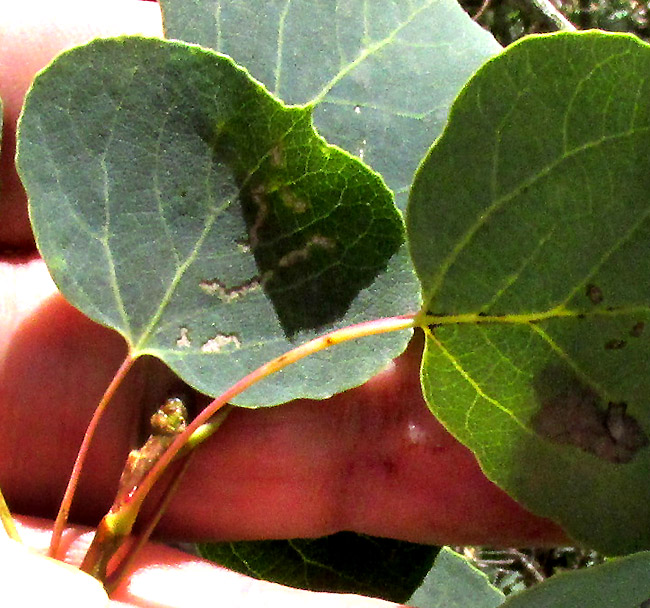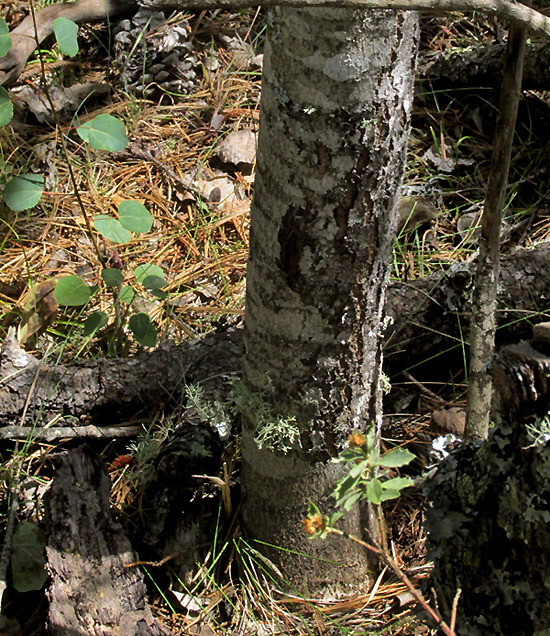Excerpts from Jim Conrad's
Naturalist Newsletter
Entry from field notes dated June 29, 2023, taken along one-lane gravel road in valley between Puerto del Zenthé and Chavarrías in mountainous area with a maze of roads too complex to say how to get there; in general it's in the mountains of east-central Querétaro state, municipality of Cadereyta de Montes, 12 straight-line kms due east of Vizarrón de Montes but much farther by twisting roads; juniper-scrub forest; limestone bedrock; elevation ~2860m (~9400 ft), Querétaro, MÉXICO, (N20.84122°, W99.60509°)
QUAKING ASPEN

On the valley floor a stretch of young forest was densely populated with Teocote Pines and the poplar species, genus Populus, shown above. All the trees were of similar height and similar age, probably having invaded the spot after an earlier cutting or burning. The poplar's small, roundish leaves with hints of scalloped, or crenate, margins, with the blades on long, slender petioles encouraging them to shake, or quake, in any breeze, looked like those of the well known and much admired Quaking Aspen of Canada and the western US's higher elevations and northeastern states. But, this was Mexico.

The leaves were green above but pale below, their petioles pinkish, and the stems glistened in some places as if resin had exuded.

Trunks were mostly smooth and gray, and slightly mottled, though it was hard to say what were bark features and what was lichens. Around the base of established trees, sprouts arose, as seen above.
The Flora del Bajío treating members of the Willow Family, the Salicaceae, to which poplars belong reports that the only poplar, genus Populus, found in our part of upland central Mexico is POPULUS TREMULOIDES, which is indeed North America's Quaking Aspen. Moreover, the Flora indicates that in the state of Querétaro Quaking Aspens have only been encountered in these east-central Mountains near the Hidalgo border. In short, here we've stumbled into a relict "island" population of Quaking Aspens left over from the Ice Age.
This isn't wild speculation. First, look at the Quaking Aspen's distribution map at Wikipedia. You may need to hover your mouse's pointer over the image and use the magnifying glass to see the green spot down in central Mexico representing us. A few other high-elevation relict islands appear in Mexico north of us. During the last Ice Age, several times North America's vegetation migrated southward, in advance of enormous continental glaciers. When the planet warmed and the glaciers retreated, vegetation zones returned northward, too. However, during warming periods, some cold-weather species, instead of moving north, went up in elevation, following cooler temperatures. We've seen the same thing with other species, as described at the bottom of our page for North America's Sweetgums.
With about 10,000 years having passed since the last glaciation, and the fact that species in genetically isolated island populations -- whether on real islands or in mountaintop refugia -- often evolve differently from their parent populations, the genetics of Mexico's mountaintop refugia species is a complex matter. Some species evolve into similar but different species, while others show certain differences, but not enough to make them different species, and other species show hardly any changes at all.
The special importance of Mexico's mountaintop refugia Quaking Aspens genetically isolated from their parent populations far to the north becomes apparent when we consider these points: